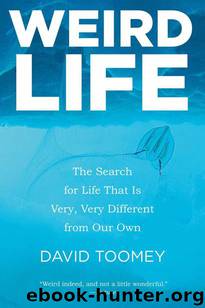Weird Life: The Search for Life That Is Very, Very Different from Our Own by David Toomey

Author:David Toomey [Toomey, David]
Language: eng
Format: epub, mobi
Publisher: W. W. Norton & Company
Published: 2013-02-25T20:00:00+00:00
The universe used to be a comfortable place. The idea that it is uncomfortable—that most nonterrestrial locales are barren and inhospitable—gained widespread acceptance only recently, in the early twentieth century. Before then and since ancient times, many astronomers, cosmologists, and philosophers assumed that the universe offered pleasant habitats in abundance. One rationale for a well-populated universe is a long philosophical tradition claiming that celestial bodies would be “wasted,” were it not for observers. Johannes Kepler, for instance, reasoned that since Jupiter’s moons cannot be seen from Earth with the naked eye, they must be meant for Jovians. In 1693, English theologian Richard Bentley enlarged the argument: “As the Earth was principally designed for the Being and Service and Contemplation of Men; why may not all other Planets be created for the like uses, each for their own inhabitants who have life and understanding.”8 Bentley’s idea of an Earth made for us, even carrying the authority of Genesis, may seem faintly risible. But it’s hard not to admire in his words an absence of self-centeredness as well—in the allowance for the possibility, if not probability, of other worlds and other beings.
Among possible habitats, some natural philosophers counted not only planets and their moons, but stars. Two thousand years ago, in his satirical work True History, Assyrian rhetorician and satirist Lucian of Samosata imagined that the Sun itself might be inhabited. As recently as the eighteenth century, no less distinguished a personage than astronomer Sir William Herschel, discoverer of the planet Uranus, supposed that the part of the Sun we see from Earth is something like our aurora borealis, and that beneath it was a layer of dense clouds that shielded denizens of the surface from our sight. Herschel’s son John suspected that the ephemeral formations we call solar flares—and he called (rather more lyrically) solar willow leaves—might themselves be living creatures. No one gives much credence to these ideas now, but there have been more recent speculations of means by which life might survive in stars—or at least, certain kinds of life and certain kinds of stars.9
WHITE DWARFS AND BLACK HOLES
Download
Weird Life: The Search for Life That Is Very, Very Different from Our Own by David Toomey.mobi
This site does not store any files on its server. We only index and link to content provided by other sites. Please contact the content providers to delete copyright contents if any and email us, we'll remove relevant links or contents immediately.
| Anatomy | Animals |
| Bacteriology | Biochemistry |
| Bioelectricity | Bioinformatics |
| Biology | Biophysics |
| Biotechnology | Botany |
| Ecology | Genetics |
| Paleontology | Plants |
| Taxonomic Classification | Zoology |
Sapiens: A Brief History of Humankind by Yuval Noah Harari(14247)
The Tidewater Tales by John Barth(12608)
Mastermind: How to Think Like Sherlock Holmes by Maria Konnikova(7223)
Do No Harm Stories of Life, Death and Brain Surgery by Henry Marsh(6887)
The Thirst by Nesbo Jo(6826)
Why We Sleep: Unlocking the Power of Sleep and Dreams by Matthew Walker(6618)
Life 3.0: Being Human in the Age of Artificial Intelligence by Tegmark Max(5474)
Sapiens by Yuval Noah Harari(5293)
The Longevity Diet by Valter Longo(5017)
The Body: A Guide for Occupants by Bill Bryson(4973)
The Rules Do Not Apply by Ariel Levy(4846)
The Immortal Life of Henrietta Lacks by Rebecca Skloot(4525)
Animal Frequency by Melissa Alvarez(4394)
Why We Sleep by Matthew Walker(4358)
The Hacking of the American Mind by Robert H. Lustig(4318)
Yoga Anatomy by Kaminoff Leslie(4303)
All Creatures Great and Small by James Herriot(4230)
Double Down (Diary of a Wimpy Kid Book 11) by Jeff Kinney(4204)
Barron's AP Biology by Goldberg M.S. Deborah T(4095)
